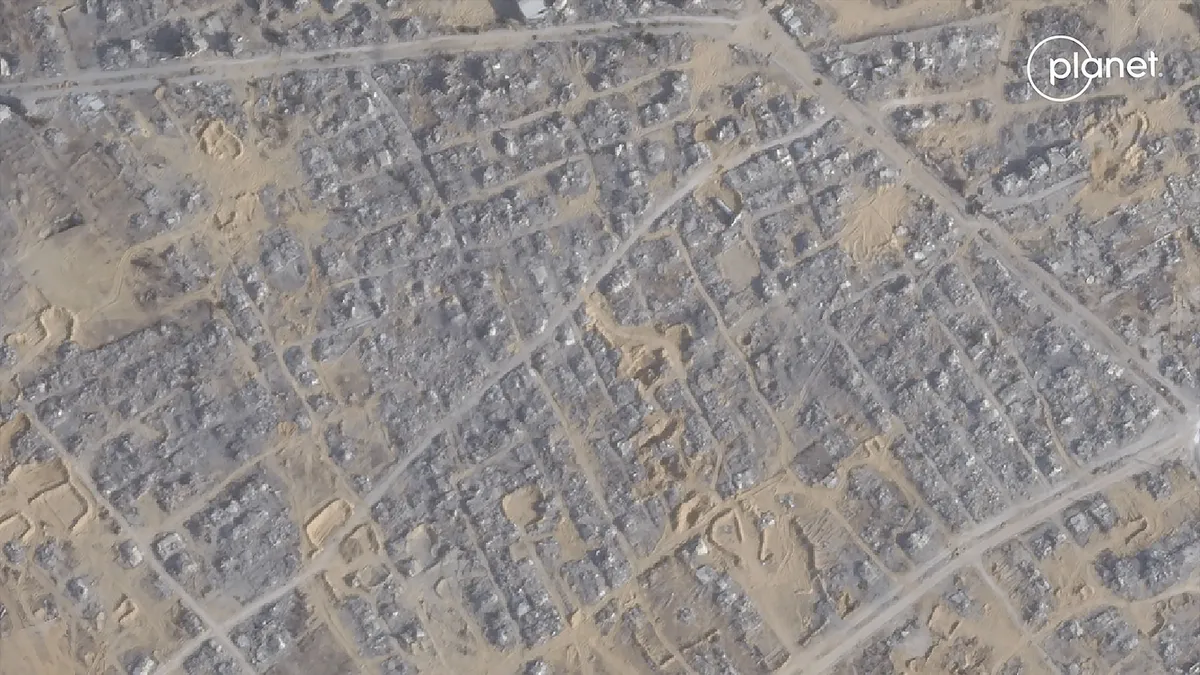
Since the Hamas terrorist attack on October 7, 2023, against Israel, the region has witnessed a significant military response, leading to widespread devastation across Gaza. An in-depth analysis by ABC News utilizing satellite imagery from the past two years reveals the extensive destruction in nearly every area of Gaza. The images depict entire towns and neighborhoods decimated, along with critical infrastructure such as schools, hospitals, and religious buildings.
Estimates indicate that as many as 197,000 buildings have been damaged or destroyed throughout the conflict. This data comes from a damage analysis shared with ABC News, conducted by Corey Scher and Jamon Van Den Hoek from Oregon State University’s Conflict Ecology lab using Copernicus Sentinel-1 satellite data.
Israeli Prime Minister Benjamin Netanyahu addressed the magnitude of destruction during an August 10 press conference, asserting that the damage is not due to Israel targeting structures with civilians present. He stated, “Israel waits until civilians leave, but Hamas operatives remain in just about every single building.” This statement highlights the complexities of military operations in densely populated areas, where Hamas allegedly uses civilian structures as shields.
Netanyahu added that Hamas operatives set off booby traps, leading to the collapse of buildings when Israeli forces enter. He explained that the destruction witnessed is a consequence of military necessity rather than indiscriminate targeting.
Two towns that have faced total destruction are Umm al-Nasser and Al-Mughraqa. Satellite imagery confirms that no buildings remain standing in these areas. Umm al-Nasser, a Bedouin town in northern Gaza, was home to nearly 5,000 residents before the conflict. Reports indicate that this town was completely flattened by the Israeli Defense Forces (IDF) between March 29 and March 31, 2025.
In response to inquiries regarding the destruction, the IDF stated that their actions comply with international law, aimed at preventing further terrorist activities. The inhabitants of Umm al-Nasser have been forced to relocate, with many now scattered in various locations across western Gaza City and the southern Gaza Strip.
Similarly, significant portions of Al Mughraqa, which had a population of approximately 11,500, were destroyed primarily between April and August 2024. During this period, the region was under Israeli control, referred to as the Netzarim corridor.
In regions where Israeli forces have maintained long-term control, such as Rafah, northern Gaza, and Khan Younis, entire blocks of buildings have been razed to the ground. In the Tal Al Sultan neighborhood of Rafah, satellite images reveal that nearly every structure has been destroyed, leaving only a few schools intact. The same grim reality is reflected in Jabalia, where extensive ground operations by Israeli forces have resulted in widespread devastation.
Despite the destruction, some displaced residents have returned to find their homes obliterated, with tents now set up amid the ruins, as seen in satellite images reviewed by ABC News.
The impact of mass displacement is starkly visible in Al Mawasi, where miles of fields have transformed into cramped camps hosting thousands of tents. This area has been designated by Israel as a humanitarian zone, directing displaced individuals to move here to avoid combat zones. However, Philippe Lazzarini, the head of the UN agency for Palestinian refugees (UNRWA), reported that essential services in Al Mawasi are severely lacking. Many displaced Palestinians face dire shortages of food, water, electricity, and adequate shelter.
Further north in Al Mawasi, the landscape is dominated by thousands of tents, creating what resembles a new city amid the conflict's chaos, as captured in satellite imagery.
According to an analysis from ABC News, 88% of schools in Gaza have been damaged or destroyed due to the ongoing conflict. At least 58% of school buildings are reported to be partially destroyed, with satellite images confirming the widespread impact on education infrastructure.
The IDF has stated that there is no policy aimed at targeting schools or educators. Instead, they cite Hamas' strategy of exploiting educational facilities for military purposes as a justification for their operations in these areas. The Al-Firdaws Elementary School, which once served 488 students in Rafah, was destroyed after sheltering displaced individuals until the spring of 2024.
In Khan Younis, five schools accommodating over 6,900 students were destroyed in August 2024, as shown in satellite imagery. The IDF has labeled these schools as part of the terrorist infrastructure, asserting that their operations were aimed at dismantling such networks in the vicinity.
As the situation in Gaza continues to evolve, the humanitarian implications of this destruction remain profound, with millions affected by the conflict's consequences.